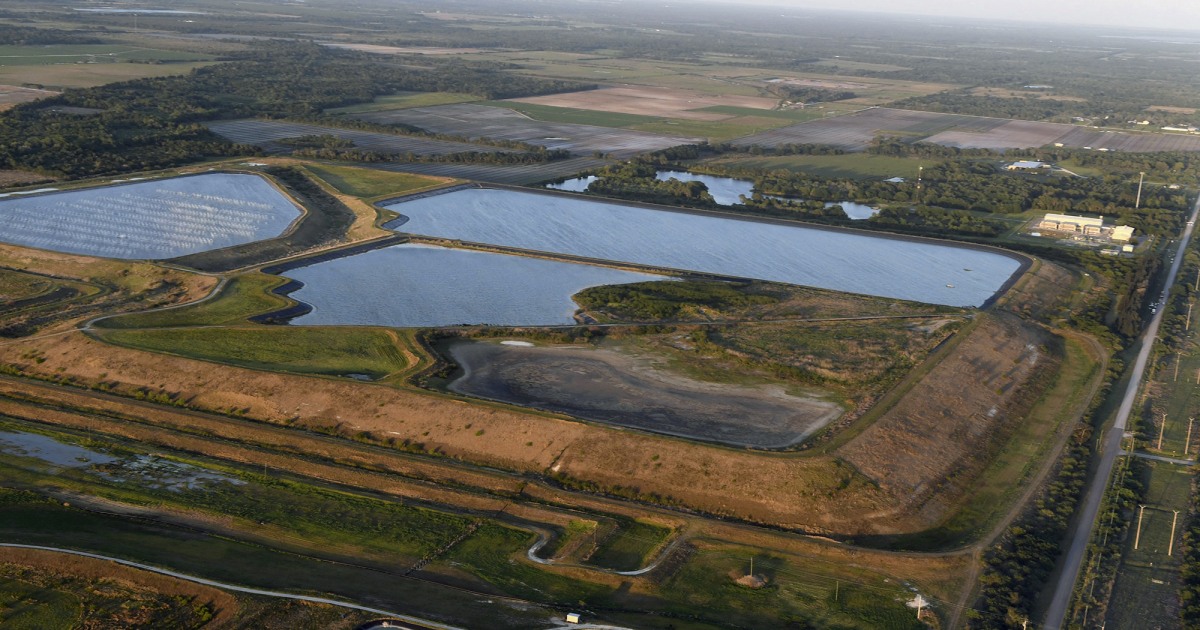As teams struggle to plug the spill in a toxic wastewater reservoir in Florida, local environmental activists that politicians have long despised say the state is witnessing a historic failure that decades of environmental catastrophes have foreshadowed.
Although the Florida Department of Environmental Protection said on Monday night that fears of a second spill at the Piney Point Reservoir were unfounded, the body of water about 40 miles south of Tampa, filled with toxic waste and runoff. of fertilizers, remains on the verge of collapse. If a total breach occurs, the area in Manatee County could suffer a “catastrophic flood,” warned Governor Ron DeSantis on Sunday.
Crews continue to pump wastewater out of the leaking reservoir, but their job may be a little too late. Over the weekend, people in more than 300 homes in the possible flood zone were forced to evacuate. If the reservoir, full of waste from an extinct phosphate plant, breaks down completely, 600 million gallons of water could spill out of the holding pool in a matter of minutes, county officials said.
Environmental advocates in the Tampa Bay area say they knew that a crisis like this was coming and are concerned about its potential short- and long-term effects.
Glenn Compton, founder of ManaSota-88, a Florida-based nonprofit environmental advocacy organization, has been eyeing Piney Point since 1968, just two years after the start of phosphate mining for fertilizers at the site.
“It has been one catastrophic crisis after another,” he said of the reservoir. “Whatever can go wrong, went wrong.”
The Piney Point reservoir sits above a pile of phosphogypsum, often called a “gyp pile,” which is a huge repository that contains the waste by-products of the phosphate fertilizer industry. Many are built to be over 60 meters high and have reservoirs at the top designed to capture rainwater.
“When the gyp stacks are so big and it rains, you don’t want rainwater to go through the stack and leak,” said Compton. The Piney Point reservoir, in theory, was designed to capture rainwater and prevent further contamination.
That would be the case, he said, if the reservoir had not been affected by a “series of failures”.
In 2006, he said, one of the lagoons was drained. In its place, site administrators placed dredged material from Port Manatee, a nearby sea port. “This pile was never intended to contain dredged material,” he said.
When the plastic liner containing the water tore in 2011, “millions of gallons of untreated wastewater were dumped from the site,” he said, polluting nearby ports and devastating fragile ecosystems.
But that leak did not generate enough changes to prevent further disasters.
Now, the reservoir is already leaking and the risk is great, he warned.
“There is no better scenario here,” said Compton, who believes the current leak could have been prevented.
At worst, water tables would end up in the bay and subsequently devastate the region’s environment and economy, said Justin Bloom, a local lawyer and founder of Suncoast Waterkeeper, a nonprofit organization that works to protect and restore waterways in Midwest Florida.
“The main reason why many people move here and live here is because it is close to the ocean and close to Tampa Bay,” he said. A total violation would be imminently dangerous and in the long run it could destroy fishing, tourism and degrade property values.
Bloom said Piney Point has a “long and sordid history” and described it as “a threat that the community has been dealing with for many years”.
“There has been a failure to properly regulate this facility and the phosphate industry in general by the local, state and federal government,” he said.
Bloom and others say that the phosphate fertilizer industry pollutes from “cradle to grave”: mining pollutes and gyp stacks also pollute.
Even if a breach is prevented, the damage is already happening. Authorities are working to pump water out of the leaking reservoir, but that water has to go somewhere.
“Where are they going to put the water?” asked Sarah Hollenhurst, an environmental activist in the area.
She suspects that the water will end up in streams and in the bay, creating the dreaded red tides or blooms of algae that are already plaguing the area. This happens when runoff feeds the growth of algae that sucks up oxygen from the water when it dies and leads to the death of fish.
Hollenhurst is also concerned about possible contamination of the aquifer, which could affect the water supply. With more than two dozen stacks of gyp in Florida, she suspects more incidents like this will occur.
“These catastrophes will continue as long as phosphate mining continues,” she said.

